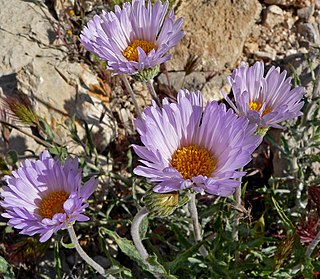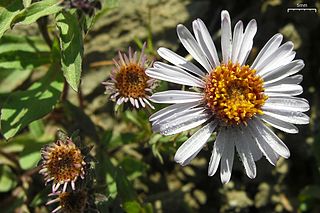
Ionactis, common name stiff-leaved asters or ankle-asters, is a small genus of plants belonging to the family Asteraceae. These aster-like plants are endemic to North America. One species is widespread across much of the eastern half of the continent, while two others are rare endemics with very restricted ranges.

Oclemena is a small genus of North American flowering plants in the tribe Astereae within the family Asteraceae.

Symphyotrichum is a genus of over 100 species and naturally occurring hybrids of herbaceous annual and perennial plants in the composite family, Asteraceae, most which were formerly treated within the genus Aster. The majority are endemic to North America, but several also occur in the West Indies, Central and South America, as well as in eastern Eurasia. Several species have been introduced to Europe as garden specimens, most notably New England aster and New York aster.

Astereae is a tribe of plants in the family Asteraceae that includes annuals, biennials, perennials, subshrubs, shrubs, and trees. They are found primarily in temperate regions of the world. Plants within the tribe are present nearly worldwide divided into over 250 genera and more than 3,100 species, making it the second-largest tribe in the family behind Senecioneae.
Eurybia spinulosa, commonly called the Apalachicola aster or pinewoods aster, is a perennial herb in the family Asteraceae. It is native to the south eastern United States, where it is present only in the Florida panhandle. Due to its restricted habitat, which is confined to the Apalachicola river drainage, as well as to ongoing development in these areas, the species is of serious conservation concern. It has been listed as critically imperiled by the Nature Conservancy and endangered by the state of Florida.

Eurybia sibirica, commonly known as the Siberian aster or arctic aster, is an herbaceous perennial native to north western North America and northern Eurasia. It is found largely in open areas of subarctic boreal forests, though it is also found in a wide variety of habitats in the region. It is similar in appearance to Eurybia merita, but their ranges overlap only near the border between the US and Canada, where E. sibirica is generally found at higher elevations.

Eurybia compacta, commonly known as the slender aster, is an herbaceous perennial native to the eastern United States from New Jersey to Georgia. It is commonly found along the coastal plain in dry sandy soils, especially in pinelands. While it is not considered to be in high danger of extinction, it is of conservation concern and has most likely been extirpated from much of its original range. The slender aster was for a long time considered to be a variety of E. surculosa, but Guy Nesom's recent research within the genus has shown that it is distinct enough to be treated as a species. It has also been shown to be related to E. avita and E. paludosa.

Eurybia conspicua, commonly known as the western showy aster, is a North American species of plants in the family Asteraceae. It is native to western Canada and the western United States.
Eurybia integrifolia, commonly called the thickstem aster, is an herbaceous perennial in the family Asteraceae. It is native to the western United States where it grows primarily in the Rocky Mountains, the Great Basin, and the Sierra Nevada in Washington, Idaho, Montana, Wyoming, Utah, Oregon, Nevada, and California.

Xylorhiza is a genus of flowering plants in the family Asteraceae, known as woodyasters. These are daisylike wildflowers usually having blue to purple or white ray flowers with yellow centers of disc florets. Woodyasters are native to western North America.

Eurybia merita, commonly known as the subalpine aster or arctic aster, is an herbaceous perennial native to northwestern North America, primarily from the Interior Mountains and Plateau system and Rocky Mountains in Canada, stretching south to Utah and extreme northern California. It is found largely in drier, open areas, generally at subalpine levels in mountains, though in more northern areas it is more common at lower elevations. It is similar in appearance to Eurybia sibirica, but their ranges only overlap near the border between the US and Canada, where E. sibirica is generally found at higher elevations than its relative. The flowers emerge in the late summer and display purple to violet ray florets and pale or creamy yellow disc florets.
Eurybia jonesiae, commonly known as Jones's aster or Almut's wood aster, is a North American species of herbaceous perennial native to the Southeastern United States, primarily in the state of Georgia with a few populations in eastern Alabama. It is found mostly in the Piedmont Region in rich oak-hickory-pine forest. Within these rich woods, it has an affinity for moist soils with habitats that include ravines, rocky ridges, and wooded slopes in the vicinity of rivers and streams. Due to its restricted range it is considered threatened by the Nature Conservancy. It has often been misidentified as Eurybia spectabilis and was declared a separate species quite recently in 1988. The flowers emerge in the late summer and persist into the fall bearing cream-coloured ray florets that become purple and yellow disc florets.

Canadanthus is a North American monotypic genus of flowering plants in the family Asteraceae. The only species is Canadanthus modestus, commonly known as great northern aster or western bog aster. It is native to most of Canada and to northern parts of the United States.
Herrickia is a former North American genus of flowering plants in the family Asteraceae, native to the western United States. In 2004 it was proposed to revive the genus with species that were included in Aster before molecular studies triggered the splitting of that genus into several distinct genera. However, the status of this genus is disputed with Plants of the World Online (POWO) synonymizing it with Eurybia as of 2023.

Eucephalus is a genus of North American flowering plants in the family Asteraceae.
Eurybia horrida is a species of flowering plant in the family Asteraceae known by the common names spiny aster and horrid herrickia. It is native to Colorado and New Mexico in the United States, where it occurs only in the Canadian River basin. It most often included in genus Eurybia.

Eurybia kingii is a North American species of flowering plants in the family Asteraceae, called the King's serpentweed or King's aster. It has been found only in the State of Utah in the western United States.
Eurybia wasatchensis is a North American species of flowering plants in the family Asteraceae, called the Wasatch aster. It has been found only in the state of Utah in the western United States.
John Cameron Semple is a botanist, cytotaxonomist, professor emeritus, and adjunct professor at the University of Waterloo in Ontario, Canada. He was born in Boston and earned a degree of Bachelor of Science in 1969 from Tufts University, followed in 1971 and 1972 by Master of Arts and Doctor of Philosophy degrees from Washington University in St. Louis. Semple is known for his work with members of the tribe Astereae, particularly goldenrods, American asters, and goldenasters, and he maintains the University of Waterloo Astereae Lab website. Semple's wife is Brenda, and in 2013, he named a newly discovered goldenrod species Solidago brendiae in honor of her.












